Haines - Alaska 2005
Updated: 11/30/08
 After
stopping by the 'oceanview' campground and finding out the nose of the fifth
wheel would be towards the water in all of the sites, we found a free camping
spot along the Lutak Inlet of the Lynn Canal. The road is quiet at night unless
a ferry comes in and that traffic is concentrated to a short time. The view is
great.
After
stopping by the 'oceanview' campground and finding out the nose of the fifth
wheel would be towards the water in all of the sites, we found a free camping
spot along the Lutak Inlet of the Lynn Canal. The road is quiet at night unless
a ferry comes in and that traffic is concentrated to a short time. The view is
great.
Our view from beside our fifth wheel.



We see the same ferries we watched out our window at Valdez .
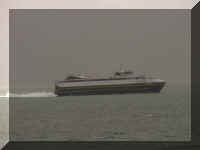
 Approaching
town from our campsite, the white buildings in a row are old Fort Seward. They
are currently privately owned and many used by artist and for cultural
activities.
Approaching
town from our campsite, the white buildings in a row are old Fort Seward. They
are currently privately owned and many used by artist and for cultural
activities.

A ride out the other side of town, past the cruise ship dock, gave us a
different view towards
town and into the water.


Haines is a small town with a population of about 1,715 people.
Its small boat harbor is smaller than others and the people are real laid back.
Hours of business are seldom posted and we have made three attempts to go to a
restaurant and have yet to find it open. This sign stating 'usually open daily'
says it all.


 We
will be in Haines during the time the Woodward Dream Cruise (WDC) is being held
in Michigan. The WDC is billed as the world's largest one-day gathering of hot
rod and vintage car enthusiasts. Just by luck, during our first visit to
downtown and the fort area, we spotted two old cars. So, we post photographs
here on Saturday, the day of the WDC.
We
will be in Haines during the time the Woodward Dream Cruise (WDC) is being held
in Michigan. The WDC is billed as the world's largest one-day gathering of hot
rod and vintage car enthusiasts. Just by luck, during our first visit to
downtown and the fort area, we spotted two old cars. So, we post photographs
here on Saturday, the day of the WDC.



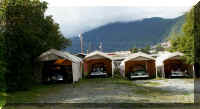 Two days later, we found where the DeSoto and four other restored
cars live. And, our Michigan friends thought we would not see nice cars in
Haines!
Two days later, we found where the DeSoto and four other restored
cars live. And, our Michigan friends thought we would not see nice cars in
Haines!
Okay, I'll admit no hot rods . . . yet.
 And,
for the children in the crowd . . .
And,
for the children in the crowd . . .
For those interested in restored cars and trucks and hot
rods,
this link to the Woodward Dream Cruise
will be interesting.
It is a large file because it is an accumulation of photographs from several years.
Okay . . . enough about the WDC. This is our Alaska 2005 trip.
 Some of Haines is built on a hill. The
sidewalks must have steps. You need to use the drivers training lesson of
turning your front wheel towards the curb to park safely.
Some of Haines is built on a hill. The
sidewalks must have steps. You need to use the drivers training lesson of
turning your front wheel towards the curb to park safely.
 One
restaurant we visited on a couple occasions has a colorful past as noted on the
mural painted on the side of the building.
One
restaurant we visited on a couple occasions has a colorful past as noted on the
mural painted on the side of the building.
The history written in the menu was an interesting read.
This is a view of the mountains behind town one evening.

 Bear viewing is a popular event during the salmon spawn. This
bear, on the roof of a business, looks like he is going camping.
Bear viewing is a popular event during the salmon spawn. This
bear, on the roof of a business, looks like he is going camping.
The Chilkoot River is a gathering spot for residents and
visitors - especially visitors. It is in the Chilkoot Lake State Park. We were there
almost every night we were in town. During
the day, humans fish the river - at night, it is the bear's turn to fish.


We are not the only people there. It is a big draw every
night.

While you wait for the bears to make their appearance, the
ducks entertain you.
They paddle upstream and float down, over and over until tired.


The main attraction is the bears . . .

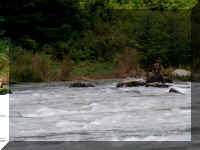
Mom and two year old
cubs ... Mom
fishing ...


Mom with
fish ...
Cub with fish ...
 Another
larger bear appeared on the other side of the weir.
Another
larger bear appeared on the other side of the weir.
 Then,
a mom and a small cub came out of the woods. This cub was born this year and was
still nursing It did not eat fish yet.
Then,
a mom and a small cub came out of the woods. This cub was born this year and was
still nursing It did not eat fish yet.
Fred tried out the digital zoom on the camera to photograph a
bear a longer distance away. This bear knew how to catch fish. He would watch
from shore and pounce on the fish - not chase them through the water like some
did. He caught two fish while we were watching.



One night on the way back to the HHII . . .
The Tsirku Canning Company museum was a very interesting
experience. It is another one of those 'flexible' hours operations so check with
them the day you arrive for the tour schedule - the visitors center sometimes
does not give the correct information. Admission is $10 per person (over 12
years old) - including the video if you are not on a bus tour, the tour takes about 1.5
hours.
It is a 'don't miss' stop.
 The
line is set to run at 1/10 normal speed so you can see the each operation. Our
tour guide 'Sam', worked in the fishing industry for ten years before becoming a
teacher. He had a wealth of information. The first three machines are a
three-piece can reform line. They are the only
remaining ones of their kind in the world. Except for these three machines, the
canning companies owned all the machines and destroyed them after the seamed can
material leaked and caused a death. These machine were the only ones privately
owned when the museum owner found them. He searched and found his equipment all
over Alaska.
The
line is set to run at 1/10 normal speed so you can see the each operation. Our
tour guide 'Sam', worked in the fishing industry for ten years before becoming a
teacher. He had a wealth of information. The first three machines are a
three-piece can reform line. They are the only
remaining ones of their kind in the world. Except for these three machines, the
canning companies owned all the machines and destroyed them after the seamed can
material leaked and caused a death. These machine were the only ones privately
owned when the museum owner found them. He searched and found his equipment all
over Alaska.
We will not show you all of the machines . . .
The three pieces consist of a flattened can and two formed
lids.
The flat stock is made into a round cylinder by this machine.


This machine is called a head indexer. Any idea what this
blade does?

 The
next machine is the 'gang' knife, that is set up to cut the fish into the exact
thickness of the particular can size the line is running.
The
next machine is the 'gang' knife, that is set up to cut the fish into the exact
thickness of the particular can size the line is running.
Salmon are all about the same size so length is not an issue.
 Here
the tops are being clinched to the can and the last machine is the vacuum
machine. Jim, the owner, was able to find the last cases of cans for his antique
cannery on a wrecked ship. When his supply runs out, a can material source is
unknown.
Here
the tops are being clinched to the can and the last machine is the vacuum
machine. Jim, the owner, was able to find the last cases of cans for his antique
cannery on a wrecked ship. When his supply runs out, a can material source is
unknown.
 The
first three machines are obsolete because the canning industry replaced the
three piece can with the sanitary can. It is pressed out of one piece of metal
and coated.
The
first three machines are obsolete because the canning industry replaced the
three piece can with the sanitary can. It is pressed out of one piece of metal
and coated.
 Even
today, the words "Canned in Alaska" is all you need to know. The brand
name on the label means nothing if those words appear. In the days of the
'rusty' cans, the label were all primarily red so the consumer did not see the
rust as easily.
Even
today, the words "Canned in Alaska" is all you need to know. The brand
name on the label means nothing if those words appear. In the days of the
'rusty' cans, the label were all primarily red so the consumer did not see the
rust as easily.
The next museum we visited was The Hammer Museum. It is a
collection of over 1,400 hammers of all kinds and for all uses. Some are more
unique and decorative than useful. But, that is what collecting is all about.
Each room in the building is set up for different eras. Admission is $3 per
person over 12 years of age. Allow 45 minutes for the walk through.


 Five
mannequins were donated by the Smithsonian Institution and restored by Dave, the
owner.
Five
mannequins were donated by the Smithsonian Institution and restored by Dave, the
owner.

 This one from 'Home Improvement" signed by Tim Taylor.
This one from 'Home Improvement" signed by Tim Taylor.


Some of the hammers are patented and were displayed with copies of the
patent.
The Sheldon Museum is also located in Haines. It originated with
a donation of items from the Stephen Sheldon family. The cst is $3 per person
over 12 years of age. It should take about an hour and a half to look at the
exhibits.
The first floor displayed more recent local history items.



Many temporary boundary post were erected
on the Provisional Boundary when, after many years
of peace, gold was found in the region. Canada decided it
needed a salt water port and was looking at Alaska's land.
The second floor presented native items.



Native blanket . . .
You don't hear much about the strife between tribes.
This exhibit did and showed armor.

Haines is the location of The American Bald Eagle Foundation.
The founder, Dave Olerud, greeted us and started the video. It was a long video - an
hour. But, it was full of information and photographs of eagles and their
habitat in the area. The founder loves his work and was a walking encyclopedia
of facts about all the animals displayed in the building. He recited the entire
cycle of nature and the food chain. The admission fee is $3 for persons
over 12 years of age. Including the video, expect to spend almost two hours.




 Did you know why a moose can search for food under water?
We learned that his
nose seals tightly on command.
Did you know why a moose can search for food under water?
We learned that his
nose seals tightly on command.
Many eagles were on display - a mature eagle with a fish and an
immature eagle.


 One
evening we went to a presentation of the Chilkat Dancers Storytelling Theater
Show. Ancient legends come alive in masks, costumes and action theatre.
Admission is $10 per person over 12 years of age. It was a good hour of
entertainment. The show is indoors so rain will not be an issue. Dress in layers
- no heat.
One
evening we went to a presentation of the Chilkat Dancers Storytelling Theater
Show. Ancient legends come alive in masks, costumes and action theatre.
Admission is $10 per person over 12 years of age. It was a good hour of
entertainment. The show is indoors so rain will not be an issue. Dress in layers
- no heat.
The four stories were: 'Tide Woman', ' Raven Goes Berry
Picking', 'The Cannibal Giant' and 'Mystery of the Fog Woman'.


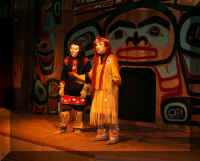


The cast . . .
The next day we stopped by the S. E. Alaska State Fair Grounds
to visit Dalton City, the movie set for White Fang. There was no admission
charged, just walk in.



It appeared that the few buildings in the movie set that were
greater than three feet deep, were being used for artist workshops. The only
activity we saw was in the Haines Brewing Company.


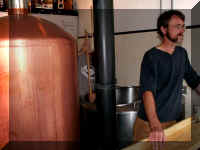
Before going back to the HHII, we drove out to Chilkat
State Park. We had talked to people in Seward who had hosted there a month.
The ride along the Chilkat Inlet was beautiful.


You are so used to seeing large fishing boats,
you can forget that some people use tiny boats
to tend to their nets..

There was an observation deck inside the state park where you
could see two glaciers.


Davidson
Glacier
Rainbow Glacier
(We were able to make better photographs of
these glaciers the next day on our boat ride to Juneau.)
As you know, we are fascinated with tide changes. These
photographs are straight out our window and a little to the right.

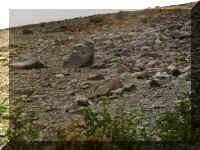


After a couple days of cloudy weather, we actually saw blue
sky and the sun hit the mountains across the water.


 A
house on the road to Chilkoot Lake State Park to see the bears fishing had
stones piled ornately all over the front yard. This is a photograph of a few of
them.
A
house on the road to Chilkoot Lake State Park to see the bears fishing had
stones piled ornately all over the front yard. This is a photograph of a few of
them.
 We
will end this page with information you needed to know. In Alaska we have been
seeing truck trailers with their tires painted. We had assumed it was so there
could see that they were turning in the snow. We were correct. Fred finally got
an opportunity to ask a trucker to confirm our thoughts. He said this way they
know a wheel has not frozen up and is turning. He said they also us a colored
strip of metal attached to a lug nut that sticks out far enough for them to see.
We
will end this page with information you needed to know. In Alaska we have been
seeing truck trailers with their tires painted. We had assumed it was so there
could see that they were turning in the snow. We were correct. Fred finally got
an opportunity to ask a trucker to confirm our thoughts. He said this way they
know a wheel has not frozen up and is turning. He said they also us a colored
strip of metal attached to a lug nut that sticks out far enough for them to see.
We enjoy our time in Haines. They was enough to do to keep us
occupied for a few days.
Return to Tok to Haines
Go back to Alaska Photo Album
.
Top of Page

 After
stopping by the 'oceanview' campground and finding out the nose of the fifth
wheel would be towards the water in all of the sites, we found a free camping
spot along the Lutak Inlet of the Lynn Canal. The road is quiet at night unless
a ferry comes in and that traffic is concentrated to a short time. The view is
great.
After
stopping by the 'oceanview' campground and finding out the nose of the fifth
wheel would be towards the water in all of the sites, we found a free camping
spot along the Lutak Inlet of the Lynn Canal. The road is quiet at night unless
a ferry comes in and that traffic is concentrated to a short time. The view is
great.






















































































